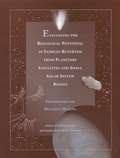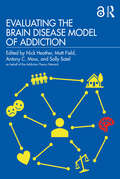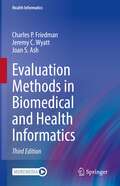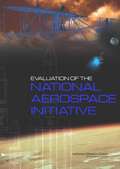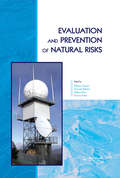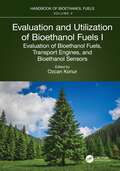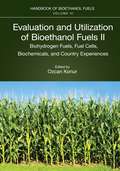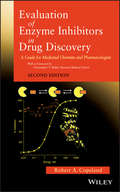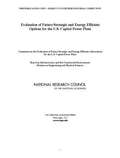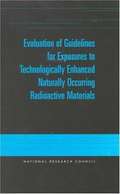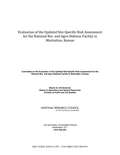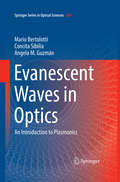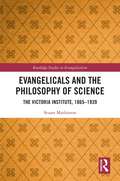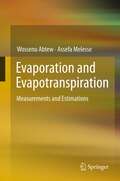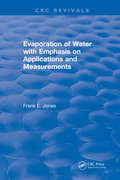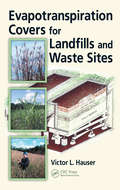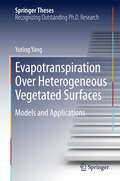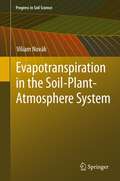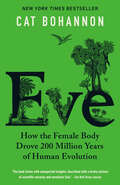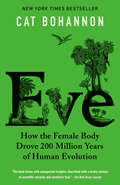- Table View
- List View
Evaluating the Biological Potential in Samples Returned from Planetary Satellites and Small Solar System Bodies: Framework for Decision Making
by Task Group on Sample Return from Small Solar System BodiesFor the first time since the Apollo program, NASA and space agencies abroad have plans to bring samples to Earth from elsewhere in the solar system. There are missions in various stages of definition to gather material over the next decade from Mars, an asteroid, comets, the satellites of Jupiter, and the interplanetary dust. Some of these targets, most especially Jupiter's satellites Europa and Ganymede, now appear to have the potential for harboring living organisms.This book considers the possibility that life may have originated or existed on a body from which a sample might be taken and the possibility that life still exists on the body either in active form or in a form that could be reactiviated. It also addresses the potential hazard to terrestrial ecosystems from extraterrestrial life if it exists in a returned sample. Released at the time of the Internationl Committee on Space Research General Assembly, the book has already established the basis for plans for small body sample retruns in the international space research community.
Evaluating the Brain Disease Model of Addiction
by Sally Satel Antony C. Moss Nick Heather Matt FieldThis ground-breaking book advances the fundamental debate about the nature of addiction. As well as presenting the case for seeing addiction as a brain disease, it brings together all the most cogent and penetrating critiques of the brain disease model of addiction (BDMA) and the main grounds for being skeptical of BDMA claims. The idea that addiction is a brain disease dominates thinking and practice worldwide. However, the editors of this book argue that our understanding of addiction is undergoing a revolutionary change, from being considered a brain disease to a disorder of voluntary behavior. The resolution of this controversy will determine the future of scientific progress in understanding addiction, together with necessary advances in treatment, prevention, and societal responses to addictive disorders. This volume brings together the various strands of the contemporary debate about whether or not addiction is best regarded as a brain disease. Contributors offer arguments for and against, and reasons for uncertainty; they also propose novel alternatives to both brain disease and moral models of addiction. In addition to reprints of classic articles from the addiction research literature, each section contains original chapters written by authorities on their chosen topic. The editors have assembled a stellar cast of chapter authors from a wide range of disciplines – neuroscience, philosophy, psychiatry, psychology, cognitive science, sociology, and law – including some of the most brilliant and influential voices in the field of addiction studies today. The result is a landmark volume in the study of addiction which will be essential reading for advanced students and researchers in addiction as well as professionals such as medical practitioners, psychiatrists, psychologists of all varieties, and social workers.
Evaluation Methods in Biomedical and Health Informatics (Health Informatics)
by Joan S. Ash Charles P. Friedman Jeremy C. WyattHeavily updated and revised from the successful first edition Appeals to a wide range of informatics professionals, from students to on-site medical information system administrators Includes case studies and real world system evaluations References and self-tests for feedback and motivation after each chapter Great for teaching purposes, the book is recommended for courses offered at universities such as Columbia University Precise definition and use of terms
Evaluation Of The National Aerospace Initiative
by Committee on the National Aerospace InitiativeThe National Aerospace Initiative (NAI) was conceived as a joint effort between the Department of Defense (DOD) and the National Aeronautics and Space Administration (NASA) to sustain the aerospace leadership of the United States through the acceleration of selected aerospace technologies: hypersonic flight, access to space, and space technologies. The Air Force became concerned about the NAI’s possible consequences on Air Force programs and budget if NAI program decisions differed from Air Force priorities. To examine this issue, it asked the NRC for an independent review of the NAI. This report presents the results of that assessment. It focuses on three questions asked by the Air Force: is NAI technically feasible in the time frame laid out; is it financially feasible over that period; and is it operationally relevant.
Evaluation and Prevention of Natural Risks
by Stefano Campus Ferruccio Forlati Secondo Barbero Stefano BovoThe assessment and prevention of risks inherent to natural phenomena is of topical interest to the scientific community and other authorities dealing with territorial management. Historical analysis carried out in the Piemonte-territory in north-western Italy, focusing on the consequences of hydrogeological risks, reveals that damage is continually
Evaluation and Utilization of Bioethanol Fuels. I.: Evaluation of Bioethanol Fuels, Transport Engines, and Bioethanol Sensors
by Ozcan KonurThis book aims to inform readers about the recent developments in the evaluation and utilization of bioethanol fuels. It covers the evaluation and utilization of bioethanol fuels in general, gasoline fuels, nanotechnology applications in bioethanol fuels, utilization of bioethanol fuels in transport engines, evaluation of bioethanol fuels, utilization of bioethanol fuels in general, and development and utilization of bioethanol fuel sensors. This book is the fifth volume in the Handbook of Bioethanol Fuels (Six-Volume Set). It indicates that research on the evaluation and utilization of bioethanol fuels has intensified in recent years to become a major part of bioenergy and biofuels research together primarily with biodiesel, biohydrogen, and biogas research as a sustainable alternative to crude oil-based gasoline and petrodiesel fuels as well as natural gas and syngas. This book is a valuable resource for stakeholders primarily in the research fields of energy and fuels, chemical engineering, environmental science and engineering, biotechnology, microbiology, chemistry, physics, mechanical engineering, agricultural sciences, food science and engineering, materials science, biochemistry, genetics, and molecular biology, plant sciences, water resources, economics, business and management, transportation science and technology, ecology, public, environmental and occupational health, social sciences, toxicology, multidisciplinary sciences, and humanities, among others.
Evaluation and Utilization of Bioethanol Fuels. II.: Biohydrogen Fuels, Fuel Cells, Biochemicals, and Country Experiences
by Ozcan KonurThe sixth volume of this handbook provides an overview of the research on the country-based experience of bioethanol fuels at large, Chinese, US, and European experience of bioethanol fuels, production of bioethanol fuel-based biohydrogen fuels for fuel cells, bioethanol fuel cells, and bioethanol fuel-based biochemicals with a collection of 17 chapters. Thus, it complements the fifth volume of this handbook. Hence, the sixth volume indicates that the research on the evaluation and utilization of bioethanol fuels has intensified in recent years to become a major part of the bioenergy and biofuels research together primarily with biodiesel, biohydrogen, and biogas research as a sustainable alternative to crude oil-based gasoline and petrodiesel fuels as well as natural gas and syngas. This book is intended for students, researchers, engineers, policy makers, economist, business managers, and social scientists, working on the production, utilization and evaluation of bioethanol fuels.
Evaluation of Demonstration Test Results of Alternative Technologies for Demilitarization of Assembled Chemical Weapons: A Supplemental Review
by National Research CouncilA review of the Evaluation of Demonstration Test Results of Alternative Technologies for Demilitarization of Assembled Chemical Weapons
Evaluation of Enzyme Inhibitors in Drug Discovery
by Robert A. CopelandOffers essential guidance for discovering and optimizing novel drug therapiesUsing detailed examples, Evaluation of Enzyme Inhibitors in Drug Discovery equips researchers with the tools needed to apply the science of enzymology and biochemistry to the discovery, optimization, and preclinical development of drugs that work by inhibiting specific enzyme targets. Readers will applaud this book for its clear and practical presentations, including its expert advice on best practices to follow and pitfalls to avoid.This Second Edition brings the book thoroughly up to date with the latest research findings and practices. Updates explore additional forms of enzyme inhibition and special treatments for enzymes that act on macromolecular substrates. Readers will also find new discussions detailing the development and application of the concept of drug-target residence time.Evaluation of Enzyme Inhibitors in Drug Discovery begins by explaining why enzymes are such important drug targets and then examines enzyme reaction mechanisms. The book covers: Reversible modes of inhibitor interactions with enzymes Assay considerations for compound library screening Lead optimization and structure-activity relationships for reversible inhibitors Slow binding and tight binding inhibitors Drug-target residence time Irreversible enzyme inactivatorsThe book ends with a new chapter exploring the application of quantitative biochemical principles to the pharmacologic evaluation of drug candidates during lead optimization and preclinical development.The Second Edition of Evaluation of Enzyme Inhibitors in Drug Discovery continues to offer a treatment of enzymology applied to drug discovery that is quantitative and mathematically rigorous. At the same time, the clear and simple presentations demystify the complex science of enzymology, making the book accessible to many fields- from pharmacology to medicinal chemistry to biophysics to clinical medicine.
Evaluation of Future Strategic and Energy Efficient Options for the U.S. Capitol Power Plant
by National Research Council of the National AcademiesThe U.S. Capitol Complex in Washington, D.C., comprises some of the most historic and symbolic buildings in the nation. The steam and chilled water required to heat and cool these buildings and related equipment is generated and distributed by the Capitol Power Plant (CPP) district energy system. Portions of the CPP system are now 50 to 100 years old and require renewal so that reliable utility services can be provided to the U.S. Capitol Complex for the foreseeable future. Evaluation of Future Strategic and Energy Efficient Options for the U.S. Capitol Power Plant provides comments on an interim set of publicly available consultant-generated options for the delivery of utility services to the U.S. Capitol Complex. The report provides recommendations to bring the interim options to completion, including suggestions for additional analyses, so that the CPP can be best positioned to meet the future strategic and energy efficiency requirements of the U.S. Capitol Complex.
Evaluation of Guidelines for Exposures to Technologically Enhanced Naturally Occurring Radioactive Materials
by National Research CouncilThe National Academies Press (NAP)--publisher for the National Academies--publishes more than 200 books a year offering the most authoritative views, definitive information, and groundbreaking recommendations on a wide range of topics in science, engineering, and health. Our books are unique in that they are authored by the nation's leading experts in every scientific field.
Evaluation of the Implementation of WFIRST/AFTA in the Context of New Worlds, New Horizons in Astronomy and Astrophysics
by Committee on an Assessment of the Astrophysics Focused Telescope Assets (AFTA) Mission Concepts"Evaluation of the Implementation of WFIRST in the Context of New Worlds, New Horizons in Astronomy and Astrophysics" assesses whether the proposed Astrophysics Focused Telescope Assets (AFTA) design reference mission described in the April 30, 2013 report of the AFTA Science Definition Team (SDT), WFIRST-2. 4, is responsive to the overall strategy to pursue the science objectives of "New Worlds, New Horizons in Astronomy and Astrophysics," and in particular, the survey's top ranked, large-scale, space-based priority: the Wide Field Infrared Survey Telescope (WFIRST). This report considers the versions of WFIRST-2. 4 with and without the coronagraph, as described in the AFTA SDT report. The report compares the WFIRST mission described in "New Worlds, New Horizons" to the AFTA SDT WFIRST-2. 4 design reference mission, with and without the coronagraph, on the basis of their science objectives, technical complexity, and programmatic rationale, including projected cost. This report gives an overview of relevant scientific, technical, and programmatic changes that have occurred since the release of "New Worlds, New Horizons," and assesses the responsiveness of the WFIRST mission to the science and technology objectives of the "New Worlds" report.
Evaluation of the Updated Site-Specific Risk Assessment for the National Bio- and Agro-Defense Facility in Manhattan, Kansas
by National Research Council Board on Agriculture and Natural Resources Division on Earth and Life Studies Board on Life Sciences Committee on the Evaluation of the Updated Site-Specific Risk Assessment for the National Bio- and Agro-Defense Facility in Manhattan, KansasSafeguarding U.S. agriculture from foreign animal diseases and protecting our food system require cutting-edge research and diagnostic capabilities. The Department of Homeland Security (DHS) and the U.S. Department of Agriculture (USDA) have embarked on an important mission to replace the aging Plum Island Animal Disease Center (PIADC) with a new facility, the National Bio- and Agro-Defense Facility (NBAF). When operational, this new facility would be the world's fourth biosafety level-4 laboratory capable of large animal research. It would serve as a critical world reference laboratory for identifying emerging and unknown disease threats, and would thus be a critical asset in securing the future health, wealth, and security of the nation. DHS selected Manhattan, Kansas, as the site for the new NBAF after an extensive site-selection process that involved an environmental impact statement. The Government Accountability Office (GAO) raised concerns about DHS's analysis of the potential spread of foot-and-mouth disease virus (FMDv), one of the most serious foreign animal disease threats. Congress directed DHS to conduct a site-specific risk assessment (SSRA) for the NBAF, instructed the National Research Council (NRC) to independently evaluate the SSRA, and prohibited obligation of NBAF construction funds until the NRC review was complete. Congress mandated that DHS revise its SSRA to address shortcomings of the 2010 SSRA, directed the NRC to evaluate the updated SSRA (uSSRA), and again prohibited obligation of construction funds until the completion of the second review. The scope for both of these SSRA reports addressed accidental release of pathogens from the NBAF in Manhattan, Kansas and excluded terrorist acts and malicious threats from its risk assessments. Evaluation of the Updated Site-Specific Risk Assessment for the National Bio- and Agro-Defense Facility in Manhattan, Kansas is the evaluation of the final uSSRA.
Evanescent Waves in Optics
by Mario Bertolotti Concita Sibilia Angela M. GuzmánThis monograph provides an introductory discussion of evanescent waves and plasmons, describes their properties and uses, and shows how they are fundamental when operating with nanoscale optics. Far field optics is not suitable for the design, description, and operation of devices at this nanometre scale. Instead one must work with models based on near-field optics and surface evanescent waves. The new discipline of plasmonics has grown to encompass the generation and application of plasmons both as a travelling excitation in a nanostructure and as a stationary enhancement of the electrical field near metal nanosurfaces. The book begins with a brief review of the basic concepts of electromagnetism, then introduces evanescent waves through reflection and refraction, and shows how they appear in diffraction problems, before discussing the role that they play in optical waveguides and sensors. The application of evanescent waves in super-resolution devices is briefly presented, before plasmons are introduced. The surface plasmon polaritons (SPPs) are then treated, highlighting their potential applications also in ultra-compact circuitry. The book concludes with a discussion of the quantization of evanescent waves and quantum information processing. The book is intended for students and researchers who wish to enter the field or to have some insight into the matter. It is not a textbook but simply an introduction to more complete and in-depth discussions. The field of plasmonics has exploded in the last ten years, and most of the material treated in this book is scattered in original or review papers. A short comprehensive treatment is missing; this book is intended to provide just that.
Evangelicals and the Philosophy of Science: The Victoria Institute, 1865-1939 (Routledge Studies in Evangelicalism)
by Stuart MathiesonThis book investigates the debates around religion and science at the influential Victoria Institute. Founded in London in 1865, and largely drawn from the evangelical wing of the Church of England, it had as its prime objective the defence of ‘the great truths revealed in Holy Scripture’ from ‘the opposition of science, falsely so called’. The conflict for them was not between science and religion directly, but what exactly constituted true science. Chapters cover the Victoria Institute’s formation, its heyday in the late nineteenth century, and its decline in the years following the First World War. They show that at stake was more than any particular theory; rather, it was an entire worldview, combining theology, epistemology, and philosophy of science. Therefore, instead of simply offering a survey of religious responses to evolutionary theory, this study demonstrates the complex relationship between science, evangelical religion, and society in the years after Darwin’s Origin of Species. It also offers some insight as to why conservative evangelicals did not display the militancy of some American fundamentalists with whom they shared so many of their intellectual commitments. Filling in a significant gap in the literature around modern attitudes to religion and science, this book will be of keen interest to scholars of Religious Studies, the History of Religion, and Science and Religion.
Evaporation and Evapotranspiration
by Assefa Melesse Wossenu AbtewThe book is a thorough presentation of theoretical and applied aspects of the evaporation and evapotranspiration process supported by data from experimental studies. It is written in a way that the theoretical background of evaporation and evapotranspiration estimation is presented in a simplified manner, comprehensive to most technical readers. The book deals with details of meteorological parameters and monitoring sensors which are needed for estimating evaporation and evapotranspiration. Errors in meteorological parameter measurements are also presented. Estimation errors, strengths, weaknesses and applicability of a wide range of evaporation and evapotranspiration estimation methods are presented along with samples of application to a certain region. Application of newer simpler methods is presented. A new technology, remote sensing application to evaporation and evapotranspiration estimation, is presented. The latest interest in the subject, climate change and evapotranspiration is presented in the last chapter. This book will be beneficial to students, hydrologists, engineers, meteorologists, water managers and others.
Evaporation of Water With Emphasis on Applications and Measurements
by Frank E. JonesThe loss of water from lakes, rivers, oceans, vegetation, and the earth, as well as man-made structures such as reservoirs and irrigation conduits, is a major concern of hydrologists and irrigation specialists. This loss, compounded by the lack of usable water in some areas, indicates a need for field and laboratory research that will contribute to the understanding of the processes and parameters that comprise and contribute to evaporation.This book emphasizes the process of the air-water interface and discusses such important topics as evaporation and condensation coefficients of water, heat and mass transfer, surface temperature, interfacial tension, convection, diffusion, thermal gradients, wind-generated waves, and the roles that these processes play in evaporation. The book also discusses subjects such as methods for suppressing evaporation using films, water vapor distribution, wind tunnel investigations, evaporation from water drops, preparation of pure water, molecular diffusion, the eddy-correlation method, and evaporation estimation methods. The book will be of considerable value to hydrologists, irrigation specialists, meteorologists, civil engineers, chemical engineers, hydraulic engineers, water resources specialists, water conservation specialists, geophysicists, environmental engineers, and anyone interested in understanding the evaporation of water and its consequences.
Evapotranspiration Covers for Landfills and Waste Sites
by Victor L. HauserNew, natural, self-renewing, and low-cost, evapotranspiration (ET) covers for landfills provide a solution to landfill waste that is clean, green, and economical. Evapotranspiration Covers for Landfills and Waste Sites examines the concept theory and the practical proof, then explains the technology, design, and application. It delineates the essen
Evapotranspiration Over Heterogeneous Vegetated Surfaces
by Yuting YangThe focus of this work is the development of models to estimate evapotranspiration (ET), investigating the partitioning between soil evaporation and plant transpiration at field and regional scales, and calculating ET over heterogeneous vegetated surfaces. Different algorithms with varying complexities as well as spatial and temporal resolutions are developed to estimate evapotranspiration from different data inputs. The author proposes a novel approach to estimate ET from remote sensing by exploiting the linkage between water and carbon cycles. At the field scale, a hybrid dual source model (H-D model) is proposed. It is verified with field observations over four different ecosystems and coupled with a soil water and heat transfer model, to simulate water and heat transfer in the soil-plant-atmosphere continuum. At the regional scale, a hybrid dual source scheme and trapezoid framework based ET model (HTEM), using remote sensing images is developed. This model is verified with data from the USA and China and the impact of agricultural water-saving on ET of different land use types is analyzed, in these chapters. The author discusses the potential of using a remote sensing ET model in the real management of water resources in a large irrigation district. This work would be of particular interest to any hydrologist or micro-meteorologist who works on ET estimation and it will also appeal to the ecologist who works on the coupled water and carbon cycles. Land evapotranspiration is an important research topic in hydrology, meteorology, ecology and agricultural sciences. Dr. Yuting Yang works at the CSIRO Land and Water, Canberra, Australia.
Evapotranspiration in the Soil-Plant-Atmosphere System
by Viliam NovakEvapotranspiration and its components (evaporation and transpiration) as a process is one of the basic terms of Earth's water balance; its importance is accented by the fact that transpiration is the vital element of the biomass production process. The second important property of evapotranspiration is its extreme consumption of solar energy, thus controlling the temperature of the atmosphere and creating favourable conditions for life. Evapotranspiration as an energy consuming process is also the connection between the energy and mass cycles of the Earth. Evapotranspiration is a process performing in the Soil-Plant -Atmosphere System (SPAS); therefore this book is presenting and quantifying it as a catenary process, describing transport of water in the soil, including root extraction patterns and methods of its evaluation. Transport of water through the plant and from the canopy to the atmosphere is also described and quantified. A variety of evapotranspiration (and its components evaporation and transpiration) calculation methods are described, starting from empirical methods up to the most sophisticated ones based on the solution of the transport equations of water and energy in the SPAS. The most important (and widely used) calculation method - modified Penman-Monteith method is described in details, ready to be used with data in the book only. Water balance method of evapotranspiration estimation as well as sap flow method description can be found in the book as well. The book can be used by hydrologists, biologists, meteorologists and other specialists as well as by ecology students. Key themes: soil hydrology - evapotranspiration - hydropedology- plant physiology - water movement in soils - evaporation - transpiration Dr. Viliam Novák is a water resources scientist at the Institute of Hydrology of the Slovak Academy of Sciences in Bratislava (Slovakia).
Eve (Adapted for Young Adults): How the Female Body Shaped Human Evolution
by Cat BohannonThe groundbreaking New York Times bestseller is now adapted for young adults! This is the 200-million-year story of how the female body gave rise to the human species and forever shaped life on Earth and what that means for us in the future.Why do women live longer than men? Why do girls score better at every academic subject than boys until puberty, when suddenly their scores plummet? Is the female brain "wired differently?" These questions and common debates around scientific claims are thoughtfully examined in this adaptation perfect for young people.This brand-new adaptation is a friendly, funny, and engaging read. It explores teen related topics such as mental health and the biology behind it, including insights on how adolescent brains are going through all kinds of changes, and shifting hormones. Author Cat Bohannon explains the roots of sexism and shows how, though it may have even served some evolutionary purpose long ago, it no longer serves us today, and it&’s high time we leave it in the past.Filled with amazing stories of both past and present, Eve will delight any young reader looking to understand the body—its amazing history, its wondrous capability, its oddities and mysteries, and its relevance to so many issues captivating contemporary thought and discussion.
Eve: How the Female Body Drove 200 Million Years of Human Evolution
by Cat BohannonAn ambitious, eye-opening, myth-busting and groundbreaking history of the evolution of the female body, by a brilliant new researcher and writer.Why do women live longer than men? Why do women have menopause? Why are women more likely to get Alzheimer&’s? Why do girls score better at every academic subject than boys until puberty, when suddenly their scores plummet? And does the female brain really exist?In Eve, Cat Bohannon answers questions scientists should have been addressing for decades. With boundless curiosity and sharp wit, she covers the past 200 million years to explain the specific science behind the development of the female sex. Eve is not only a sweeping revision of human history, it&’s an urgent and necessary corrective for a world that has focused primarily on the male body for far too long. Bohannon&’s findings, including everything from the way C-sections in the industrialized world are rearranging women&’s pelvic shape to the surprising similarities between pus and breast milk, will completely change what you think you know about evolution and why Homo sapiens have become such a successful and dominant species, from tool use to city building to the development of language.A 21st-century update of Our Bodies, Ourselves, Eve offers a true paradigm shift in our thinking about what the female body is and why it matters.
Eve: How the Female Body Drove 200 Million Years of Human Evolution
by Cat Bohannon&“A page-turning whistle-stop tour of mammalian development that begins in the Jurassic Era, Eve recasts the traditional story of evolutionary biology by placing women at its center…. The book is engaging, playful, erudite, discursive and rich with detail." —The New York Times&“A smart, funny, scientific deep-dive into the power of a woman&’s body, Eve surprises, educates, and emboldens.&”—Bonnie Garmus, #1 New York Times best-selling author of Lessons in ChemistryAn ambitious, eye-opening, myth-busting and groundbreaking history of the evolution of the female body, by a brilliant new researcher and writerWhy do women live longer than men? Why do women have menopause? Why are women more likely to get Alzheimer&’s? Why do girls score better at every academic subject than boys until puberty, when suddenly their scores plummet? And does the female brain really exist?In Eve, Cat Bohannon answers questions scientists should have been addressing for decades. With boundless curiosity and sharp wit, she covers the past 200 million years to explain the specific science behind the development of the female sex. Eve is not only a sweeping revision of human history, it&’s an urgent and necessary corrective for a world that has focused primarily on the male body for far too long. Bohannon&’s findings, including everything from the way C-sections in the industrialized world are rearranging women&’s pelvic shape to the surprising similarities between pus and breast milk, will completely change what you think you know about evolution and why Homo sapiens have become such a successful and dominant species, from tool use to city building to the development of language.A 21st-century update of Our Bodies, Ourselves, Eve offers a true paradigm shift in our thinking about what the female body is and why it matters.
Eve: How the Female Body Drove 200 Million Years of Human Evolution
by Cat BohannonNEW YORK TIMES BESTSELLER • WOMEN'S PRIZE FOR NON-FICTION FINALIST • THE REAL ORIGIN OF OUR SPECIES: a myth-busting, eye-opening landmark account of how humans evolved, offering a paradigm shift in our thinking about what the female body is, how it came to be, and how this evolution still shapes all our lives today &“A page-turning whistle-stop tour of mammalian development that begins in the Jurassic Era, Eve recasts the traditional story of evolutionary biology by placing women at its center…. The book is engaging, playful, erudite, discursive and rich with detail." —Sarah Lyall, The New York Times &“A smart, funny, scientific deep-dive into the power of a woman&’s body, Eve surprises, educates, and emboldens.&”—Bonnie Garmus, #1 New York Times best-selling author of Lessons in Chemistry How did the female body drive 200 million years of human evolution? • Why do women live longer than men? • Why are women more likely to get Alzheimer&’s? • Why do girls score better at every academic subject than boys until puberty, when suddenly their scores plummet? • Is sexism useful for evolution? • And why, seriously why, do women have to sweat through our sheets every night when we hit menopause? These questions are producing some truly exciting science – and in Eve, with boundless curiosity and sharp wit, Cat Bohannon covers the past 200 million years to explain the specific science behind the development of the female sex: &“We need a kind of user's manual for the female mammal. A no-nonsense, hard-hitting, seriously researched (but readable) account of what we are. How female bodies evolved, how they work, what it really means to biologically be a woman. Something that would rewrite the story of womanhood. This book is that story. We have to put the female body in the picture. If we don't, it's not just feminism that's compromised. Modern medicine, neurobiology, paleoanthropology, even evolutionary biology all take a hit when we ignore the fact that half of us have breasts. So it's time we talk about breasts. Breasts, and blood, and fat, and vaginas, and wombs—all of it. How they came to be and how we live with them now, no matter how weird or hilarious the truth is.&” Eve is not only a sweeping revision of human history, it&’s an urgent and necessary corrective for a world that has focused primarily on the male body for far too long. Picking up where Sapiens left off, Eve will completely change what you think you know about evolution and why Homo sapiens has become such a successful and dominant species.
Eve: The Disobedient Future of Birth
by Claire HornThroughout human history, every single one of us has been born from a person. So far. But that is about to change.Scientific research is on the cusp of being able to grow babies outside human bodies, from machines, for the very first time. Claire Horn takes us on a truly radical and urgent deep dive into the most challenging and pertinent questions of our age. Could artificial wombs allow women to redistribute the work of gestating? How do we protect reproductive and abortion rights? And who exactly gets access to this technology, in ourvastly unequal world?In this interrogative and fascinating story of modern birth, Eve imagines with eyeopening clarity what all this might mean for the future of humanity.
